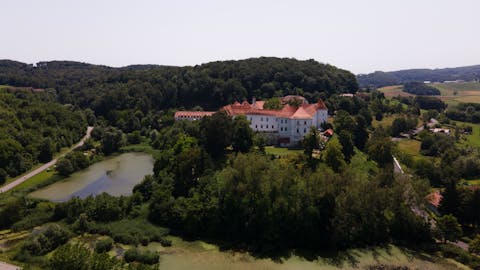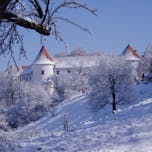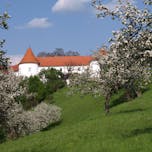
Lenart Municipality
Hrastovec Castle
Hrastovec Castle stands on a hill above the valley of the Pesnica River and is one of the most imposing preserved castles in Slovenian Styria. The name Hrastovec – Gvtenhage first appears in 1265 in connection with a ducal land register, although it is reasonable to assume that the name is related to a settlement or a smaller manor. It is, however, proven that the Hrastovec manor already existed in 1294. A single glance at the magnificent castle tells us that its owners were important nobles, among whom the statesman, diplomat, and intellectual Žiga Herberstein (1486–1566) certainly stands out; he visited Hrastovec Castle on multiple occasions. The Herberstein family significantly expanded the estate and the castle, remaining its owners until 1802, when it was purchased by the Pauer brothers. In 1909, the Herbersteins bought the castle back and retained ownership until the Second World War. Adorned with individual Renaissance architectural elements, the castle acquired its lavish Baroque appearance in the 17th century, following the designs of architect Domenico Della Torre. Inside, it features a richly designed Baroque staircase and a Baroque Knights’ Hall, where the walls are decorated with depictions of mythological and genre scenes as well as motifs of classical landscapes. The ceremonial hall, the ceiling of the former castle corridor, the castle chapel, and the staircase contain very high-quality Baroque stucco work from the first half of the 18th century. After the war, the castle served as an internment camp for people allegedly unsympathetic to the new authorities. Below the castle, in the ponds, lies the burial site of 19 inhabitants of Lenart who were killed in May 1945. In 1948, the Hrastovec–Trate Institute for the Mentally and Nervously Ill was established in the castle, and it still operates within the castle complex today. Part of the complex also includes a system of ponds.
The castle is also shrouded in the veil of the tragic love story of Agata of Štralek and Count Friderik Herberstein. Their tale is retold in the tourism product Escape into the History of Witchcraft.

